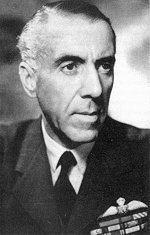Allegiance United Kingdom Years of service 1912–1945 Rank Air chief marshal | Name Richard Peirse Died August 5, 1970 | |
 | ||
Born 30 September 1892Croydon, England ( 1892-09-30 ) Commands held Allied Air Command South-East AsiaAir Forces in IndiaBomber CommandPalestine Transjordan CommandRAF HeliopolisRAF GosportNo. 222 Squadron Battles/wars First World WarSecond World War Awards Knight Commander of the Order of the BathDistinguished Service OrderAir Force CrossMentioned in Despatches (3) Similar People Charles Portal - 1st Viscount, Sir Arthur Harris - 1st Baronet, Carl Andrew Spaatz, Archibald Wavell - 1st Earl Wavell, Takeo Kurita | ||
Battles and wars World War I, World War II | ||
Air Chief Marshal Sir Richard Edmund Charles Peirse, (30 September 1892 – 5 August 1970) was a senior Royal Air Force commander.
RAF career
Born the son of Admiral Sir Richard Peirse and educated at Monkton Combe School and at King's College London, Peirse became a midshipman in the Royal Navy Volunteer Reserve and was commissioned in 1912. He was awarded the Distinguished Service Order for his contribution to the aerial attack on Dunkirk on 23 January 1915. and was promoted to flight commander in May 1915. He was further promoted in July 1916 to squadron commander.
Later that year, on 18 August 1915, Peirse married Mary Joyce Ledgard (1894–1975), younger daughter of Mr and Mrs Armitage Ledgard, of the Manor House, Thorner, Yorkshire. They had one son and one daughter. The marriage was dissolved in 1945.
Peirse served as a pilot with the Royal Naval Air Service until 1 April 1918 when it became part of the Royal Air Force. With the formation of the RAF, Peirse became Officer Commanding No. 222 Squadron. Following promotion to wing commander in January 1922, in 1923 he became Station Commander at RAF Gosport and in 1929 he was made Station Commander at RAF Heliopolis. He was also promoted to group captain in 1929. He went on to be Deputy Director of Operations and Intelligence at the Air Ministry in 1930 and, having been promoted to Air Commodore in 1933, was appointed Air Officer Commanding Palestine Transjordan Command. Promoted again, this time to Air Vice-Marshal in 1936, he was appointed Deputy Chief of the Air Staff and Director of Operations and Intelligence in January 1937.
In the Second World War, as a temporary air marshal, he became Vice-Chief of the Air Staff from April 1940 and having had his rank confirmed as permanent in July, he became Air Officer Commanding-in-Chief Bomber Command from October 1940. He presided over a large expansion in the bomber force (and appeared in the propaganda film Target for Tonight). He was transferred to other duties in January 1942 by the Chief of the Air Staff, Air Chief Marshal Charles Portal, reportedly after Peirse expressed his concern regarding the heavy losses being sustained by Bomber Command.
During early 1942, Peirse was appointed commander of Allied air forces in South East Asia and the South West Pacific, a post known as ABDAIR and part of the short-lived American-British-Dutch-Australian Command (ABDA). As the Dutch East Indies fell to Japanese forces, during February and March, ABDA was dissolved.
In March 1943 Peirse was appointed Air Officer Commanding-in-Chief RAF India and in November 1943 he was made Allied Air Commander in Chief, South-East Asia. He oversaw the building of his command from a small demoralised and poorly organised force with a collection of obsolescent aircraft into a powerful force with a three to one numerical superiority over the enemy. Although seen as somewhat aloof, he fought fiercely to bring the structure and resources needed for his command and was seen to make an able contribution to the higher direction of the war in the South East Asian theatre.
After a six-month extension, his term of office expired in November 1944 and was not renewed. He retired in May 1945 with the rank of air chief marshal but never received advancement to the Grand Cross level in the orders of knighthood which would normally have been forthcoming to an officer of his rank at the time. The reason for the abrupt termination of his career lay in his affair with Lady (Jessie) Auchinleck, the wife of his friend, Field Marshal Sir Claude Auchinleck, then Commander in Chief India.
The affair became known to Mountbatten in early 1944, and he passed the information to the Chief of the RAF, Sir Charles Portal, hoping that Peirse would be recalled. The affair was common knowledge by September 1944, and Peirse was considered to be neglecting his duties. Mountbatten sent Peirse and Lady Auchinleck back to England on 28 November 1944, where they lived together at a Brighton hotel. Peirse had his marriage dissolved in 1945, and the Auchinlecks divorced in December 1945. Peirse and the former Lady Auchinleck married the following year.
